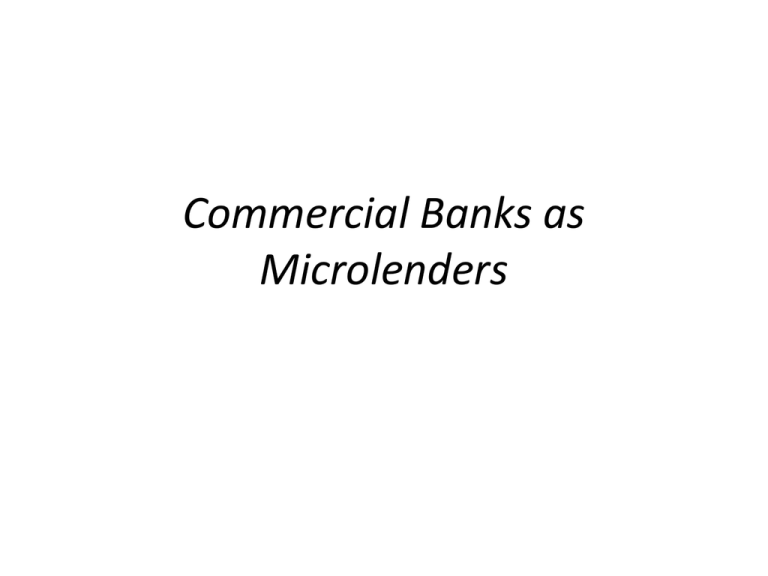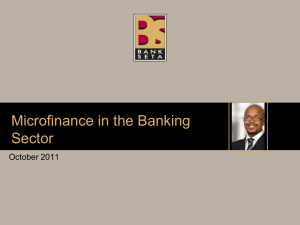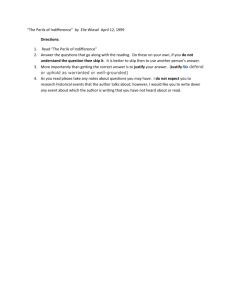Commercial Banks as Microlenders
advertisement

Commercial Banks as Microlenders Summary of the Last Lecture • As can be seen from the findings of last lecture, the advantages commercial banks can capitalize on arise from their market position, while most of the obstacles involve the need to change internal ways of thinking and operating. Summary of the Last Lecture • Successful strategies provide a structure that uses the positional advantages of banks while preventing the attitudes and processes of traditional banking from hobbling microfinance. Incredulity, Ignorance, and Indifference • I can summarize the reasons banks have not served the poor in three words: incredulity, ignorance, and indifference. —Michael Chu, Harvard Business School Incredulity, Ignorance, and Indifference • I can summarize the reasons banks have not served the poor in three words: incredulity, ignorance, and indifference. —Michael Chu, Harvard Business School Incredulity, Ignorance, and Indifference • It is not a unique criticism to say that many people inside banks regard BOP clients with incredulity, ignorance, and indifference. Such attitudes have long been widely held and deeply entrenched, not just among banks, but in almost all formal Incredulity, Ignorance, and Indifference • institutions—in fact they often characterize societal attitudes at large. It is important to acknowledge these attitudes openly because they pose real obstacles that banks must overcome before they can carry off microenterprise lending successfully. Incredulity, Ignorance, and Indifference • Incredulity that low-income people can be good customers can be addressed with firsthand examples, such as Mibanco in Peru, a microfinance institution that has become a commercial bank. Mibanco’s strong profitability and resilience helps explain why banks have entered microlending in Latin America. Incredulity, Ignorance, and Indifference • Ignorance of how to serve the market requires learning from experienced practitioners, such as ACCION, or from staff hired away from competitors. Most important, overcoming indifference requires leadership and wellstructured incentives. Incredulity, Ignorance, and Indifference • As we look now at some of the practical challenges involved in launching microfinance operations in a bank, note how the practical solutions also address these “softer” obstacles. Microlending Needs Its Own Room • The core challenge for banks that want to downscale is that lending to microenterprise clients requires a credit evaluation process fundamentally different from standard banking procedures. Microlending Needs Its Own Room • The people who operate small income-earning activities lack the handles banks normally rely on—formal identification, business records, credit history, and an easy way to protect against loss. They don’t have the salary pay stubs (from respectable formal employers) that underpin most consumer finance. Microlending Needs Its Own Room • To compensate, microfinance methodologies center on a specific relationship between the loan officer and the client. The replication of this relationship millions of times is one of the key factors making microfinance a significant global force today. Microlending Needs Its Own Room • Take Jesse Cabacheco, a loan officer of Mibanco in Peru. He spends each day walking through the markets or knocking on doors to visit his existing clients and meet new ones. Microlending Needs Its Own Room • He can eyeball a fish seller’s business and assess its inventory and turnover while carrying out a friendly conversation with the client. He probes to determine whether a customer is telling a cogent and credible story, Microlending Needs Its Own Room • and he has developed a sixth sense about the client’s willingness to repay. He can do this in part because he grew up in a neighborhood very similar to the one he works in now. Microlending Needs Its Own Room • Mibanco has trained him to turn his streetbased observations into a cash flow and ratio analysis of microenterprise creditworthiness that will result in solid lending decisions. Microlending Needs Its Own Room • Cabacheco is responsible for all aspects of the clients in his portfolio, from first promotion through collections and renewal. Only if the client is very late in repaying will another staff member step in. Microlending Needs Its Own Room • Microlending operations are structured around making this relationship work. Cabacheco’s take-home pay depends on how energetically he develops new clients and retains existing clients, and on the quality of the resulting loan portfolio. Microlending Needs Its Own Room • He was recruited for his rapport with microentrepreneurs, willingness to spend his days outdoors, and ability to think with numbers. In most consumer finance, by contrast, the credit process follows an assembly line of discrete steps, each carried out by a different Microlending Needs Its Own Room • specialist—sales, applications, approvals, verification, and collections. The credit factory approach, while efficient, does not work well with microenterprise lending. Microlending Needs Its Own Room • The lending methodology differences have many practical dimensions. Informationtechnology systems support the loan officer’s daily routine and allow supervisors to track his performance. Microlending Needs Its Own Room • Salary scales and incentive systems may be incompatible with mainstream operations. For example, many skilled loan officers in microfinance operations make salaries equivalent to tellers in mainstream branches. Microlending Needs Its Own Room • And there are cultural dimensions, too. Loan officers with Cabacheco’s profile may not be respected by bank staff who come from higher social levels. Because their clients come from the lowest social stratum, microfinance operations may be treated as second-class within the bank. The result? Microlending Needs Its Own Room • The bank’s IT people are too busy to work on getting the microloan systems right. The human resources department does not know where to recruit the right kind of staff. Senior managers do not regard supporting microlending as the route to career advancement. Microlending Needs Its Own Room • It is not hard to see the solution to this challenge, and ACCION’s experience has repeatedly borne this out. The solution is to create a distinct organizational space for microlending operations, Microlending Needs Its Own Room • a space in which it can be supported by the bigger bank, but allowed to differ in the key dimensions that make it work. Microlending needs room to be itself. Models of Downscaling • Banks can create the space for microlending through a variety of structures, ranging from internal divisions to separate financial subsidiaries. Models of Downscaling • The choice of structure depends in part on the operational and cultural considerations just described, but is often dictated by factors like regulatory environment, involvement of other investors, risk appetite, image/branding, and infrastructure. Models of Downscaling • The most frequent model of bank downscaling, although not always the most successful, is internal. In this model, a bank establishes a division of microfinance within its normal operations. Banco Wiese Sudameris (BWS) of Peru (now Scotiabank Peru) pursued several strategies to engage with the lowincome market before settling on its current path. Models of Downscaling • First, it began financing small microfinance nongovernmental organizations, and then it made a brief, unsuccessful foray into microenterprise and agricultural credit on its own. Models of Downscaling • In 1997, BWS became a minority shareholder in the microfinance bank Mibanco, which allowed it an inside look at microfinance operations. Models of Downscaling • Managers decided not to develop microlending using the special techniques described above and instead treated microloans as a standard part of branch operations. Models of Downscaling • Managers decided not to develop microlending using the special techniques described above and instead treated microloans as a standard part of branch operations. Models of Downscaling • For one thing, the bank did not send loan officers into the field to attract borrowers. Consequently, its microlending portfolio was limited to walk-ins. Since its branches were located in higher-income neighborhoods, these clients tended to be at the surface of the BOP market. Models of Downscaling • Microlending was merged into normal retail branch operations (the bank has a strong consumer line of business), which lowered cost. Models of Downscaling • BWS’s microfinance lending broke even within six months, and, on a moderate scale, the bank quickly developed a profitable portfolio—of $40 million in 2005—which has grown since then at a modest rate. Models of Downscaling • This model has worked well for a bank that chose a no-fuss approach to microlending, but it has not allowed the bank to go significantly deeper or to capture a significant share of the BOP market. Summary • Incredulity, Ignorance, and Indifference • Microlending Needs Its Own Room • Models of Downscaling







